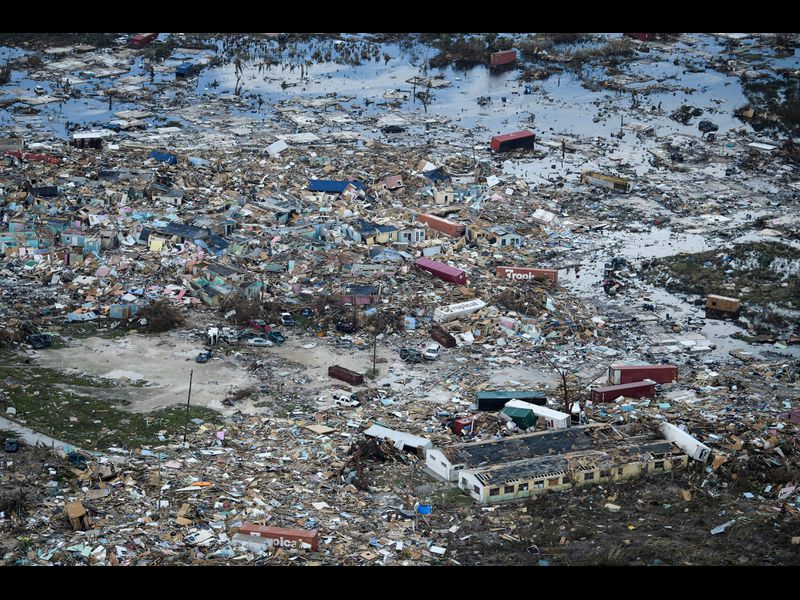
As the Bahamas endures another storm threat, previous tropical activity over the island has served as a demonstration that the true power of tropical forces are their ability to move water quickly.
The death toll in the Bahamas is still climbing and factors responsible for those deaths have not yet been determined. The total count at the time of this report is 51 with around 1,300 still unaccounted for.
However, NASA projections show that the largest rainfall amounts brought 36 inches of water to the island nation which has homes no more than 40 feet above sea level at their highest points. This does not account for the level of storm surge which left neighborhoods underwater.
The Carolinas also saw a large area of rainfall between 16 and 24 inches, NASA showed.
The Associated Press reported that the Grand Bahama airport was under 6 feet of water.
Exact amounts of storm surge and the effects it had on the population will likely come out later this year, but Dorian’s wet presence illustrated what the NHC finds to be the most dangerous part of a hurricane.
“When you close your eyes and we ask what do you see when you think of a hurricane, most people say the wind,” said Ken Graham Director of NOAA’s National Weather Service during a webinar held earlier this year. “But water is what kills."
A record amount of rain was set in 2018 for both North Carolina, 35 inches, and South Carolina, 26 inches, during Hurricane Florence.
Florence was directly responsible for 22 deaths and indirectly responsible for 30.
Experts also found that 90 percent of hurricane-related deaths were water related, according to NOAA. The major player responsible for those deaths was the storm surge, which accounted for 49 percent of hurricane related deaths.
“It is water, not the wind, that is the overwhelming killer in tropical cyclones, and the majority of those are due to storm surge,” said NOAA spokesperson Dennis Feltgen.

NOAA experts have found the most popularly misconceived idea is that wind is the deadliest force in a hurricane’s utility belt.
To shine a spotlight on the overlooked truth, the NHC began offering storm surge watches and warnings to oceanic exposed states, Feltgen said. Their efforts to educate the public seem to have worked.
“In 2017 to 2018, despite several significant hurricane landfalls, the total number of storm surge deaths reported was limited to five,” he said.
In 2019, these warnings were expanded to include Puerto Rico and the U.S. Virgin Islands.
Another misconception surrounding hurricanes is that storm surge can only affect coastal residents.
Hurricane Florence proved otherwise.
The most powerful storm surges to affect North Carolina were seen not on the coast, but instead 100 miles inland coming from associated rivers, Graham said. Coastal water would surge up the river and get trapped, forcibly moving its way out the banks and into communities.
NOAA’s analysis of the deaths associated with water found that more than half of deaths were vehicle related, possibly suggesting individuals underestimated the effect of the surges.
Residents of the Bahamas saw massive amounts of storm surge enter their communities with reports of sharks swimming in ocean waters in residential neighborhoods, according to a BBC News article.
While water statistically is more dangerous, wind is not without its own threats as the Bahamas experienced historically powerful maximum sustained winds of 185 mph and gusts of 220 mph. As a result many homes were left without roofs.
With the country still reeling from the effects of Hurricane Dorian, the tropics began serving up more potential threats, first with the same northern islands falling under the cone of uncertainty for Tropical Storm Humberto.
In the days ahead of Humberto’s approach to the islands, residents struggled to prepare without proper shelter to take cover in, according to a post on Reddit asking for donors to bring tarps.
“We need to get tarps on the ground immediately to help secure structures in Treasure Cay,” wrote u/kennicott in the post. "Dorian ripped off many roofs, made holes in others, and breached buildings in different places making them unusable and unsuitable for secure shelter. Getting tarps in on the ground will help make these otherwise unusable shelters secure for relief workers and those who are still sheltering in the area.
After Humberto, a tropical system set to become Hurricane Jerry had at one point threatened to pass near the islands, and more systems keep popping up in the tropics as the year’s hurricane season passes through the busiest month.